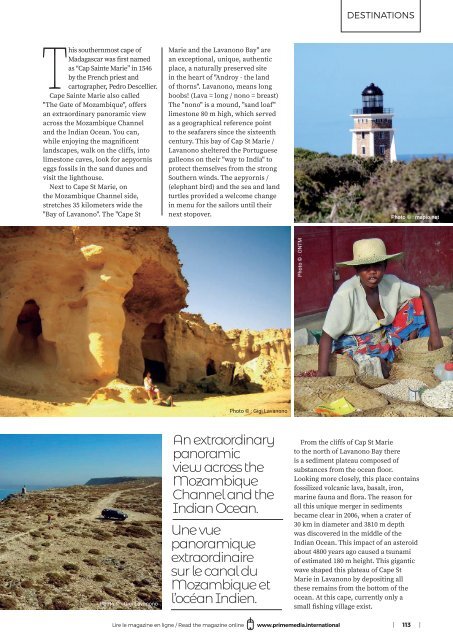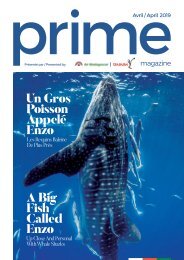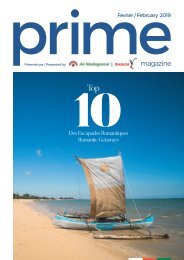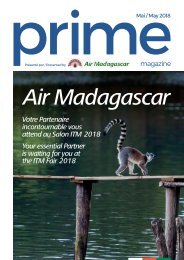PRIME MAG - AIR MAD - JULY 2018 -all- LO-RES
Create successful ePaper yourself
Turn your PDF publications into a flip-book with our unique Google optimized e-Paper software.
DESTINATIONS<br />
This southernmost cape of<br />
Madagascar was first named<br />
as “Cap Sainte Marie” in 1546<br />
by the French priest and<br />
cartographer, Pedro Descellier.<br />
Cape Sainte Marie also c<strong>all</strong>ed<br />
"The Gate of Mozambique", offers<br />
an extraordinary panoramic view<br />
across the Mozambique Channel<br />
and the Indian Ocean. You can,<br />
while enjoying the magnificent<br />
landscapes, walk on the cliffs, into<br />
limestone caves, look for aepyornis<br />
eggs fossils in the sand dunes and<br />
visit the lighthouse.<br />
Next to Cape St Marie, on<br />
the Mozambique Channel side,<br />
stretches 35 kilometers wide the<br />
"Bay of Lavanono". The "Cape St<br />
Marie and the Lavanono Bay" are<br />
an exceptional, unique, authentic<br />
place, a natur<strong>all</strong>y preserved site<br />
in the heart of "Androy - the land<br />
of thorns". Lavanono, means long<br />
boobs! (Lava = long / nono = breast)<br />
The "nono" is a mound, "sand loaf"<br />
limestone 80 m high, which served<br />
as a geographical reference point<br />
to the seafarers since the sixteenth<br />
century. This bay of Cap St Marie /<br />
Lavanono sheltered the Portuguese<br />
g<strong>all</strong>eons on their "way to India" to<br />
protect themselves from the strong<br />
Southern winds. The aepyornis /<br />
(elephant bird) and the sea and land<br />
turtles provided a welcome change<br />
in menu for the sailors until their<br />
next stopover.<br />
Photo © : mapio.net<br />
Photo © : ONTM<br />
Photo © : Gigi Lavanono<br />
Photo © : Gigi Lavanono<br />
An extraordinary<br />
panoramic<br />
view across the<br />
Mozambique<br />
Channel and the<br />
Indian Ocean.<br />
Une vue<br />
panoramique<br />
extraordinaire<br />
sur le canal du<br />
Mozambique et<br />
l’océan Indien.<br />
From the cliffs of Cap St Marie<br />
to the north of Lavanono Bay there<br />
is a sediment plateau composed of<br />
substances from the ocean floor.<br />
Looking more closely, this place contains<br />
fossilized volcanic lava, basalt, iron,<br />
marine fauna and flora. The reason for<br />
<strong>all</strong> this unique merger in sediments<br />
became clear in 2006, when a crater of<br />
30 km in diameter and 3810 m depth<br />
was discovered in the middle of the<br />
Indian Ocean. This impact of an asteroid<br />
about 4800 years ago caused a tsunami<br />
of estimated 180 m height. This gigantic<br />
wave shaped this plateau of Cape St<br />
Marie in Lavanono by depositing <strong>all</strong><br />
these remains from the bottom of the<br />
ocean. At this cape, currently only a<br />
sm<strong>all</strong> fishing village exist.<br />
Lire le magazine en ligne / Read the magazine online<br />
www.primemedia.international<br />
| 113 |















